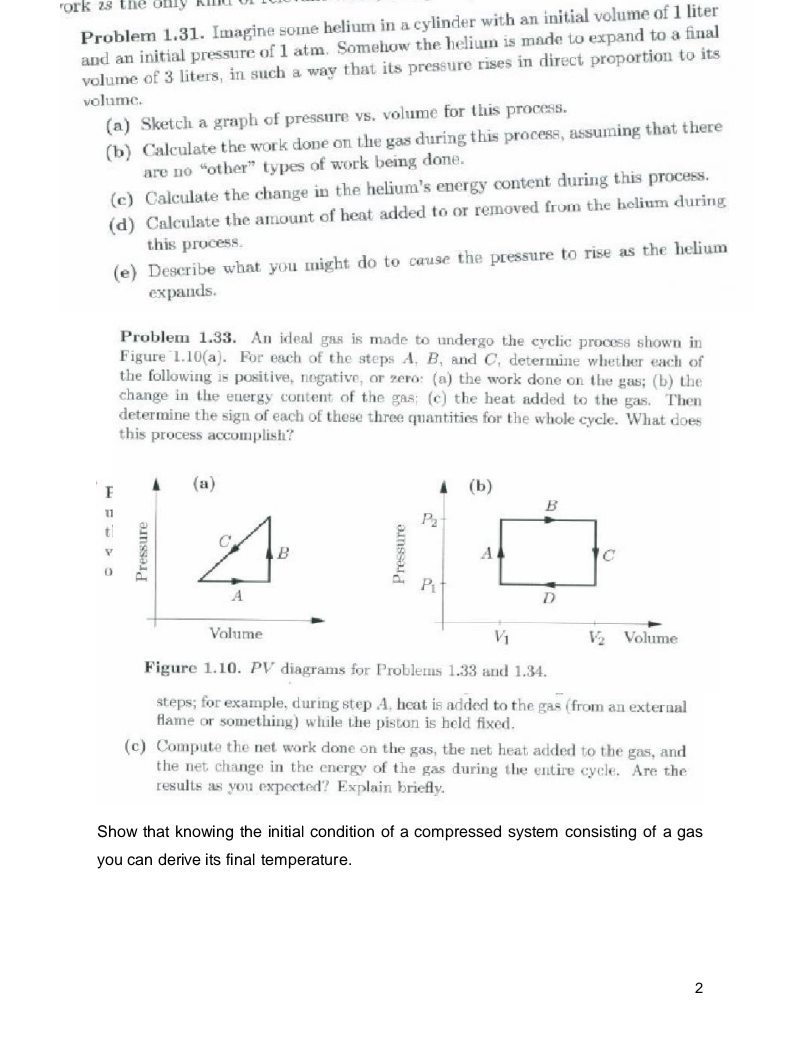Problem 1.31. Imagine some helium in a cylinder with an initial volume of 1 liter and an initial pressure of 1 atm. Somehow the helium is made to expand to a final volume of 3 liters, in such a way that its pressure rises in direct proportion to its volume. (a) Sketch a graph of pressure vs. volume for this process. (b) Calculate the work done on the gas during this process, assuming that there are no "other" types of work being done. (c) Calculate the change in the helium's energy content during this process. (d) Calculate the amount of heat added to or removed from the helium during this process. (e) Describe what you might do to cause the pressure to rise as the helium expands.
Problem 1.31. Imagine some helium in a cylinder with an initial volume of 1 liter and an initial pressure of 1 atm. Somehow the helium is made to expand to a final volume of 3 liters, in such a way that its pressure rises in direct proportion to its volume. (a) Sketch a graph of pressure vs. volume for this process. (b) Calculate the work done on the gas during this process, assuming that there are no "other" types of work being done. (c) Calculate the change in the helium's energy content during this process. (d) Calculate the amount of heat added to or removed from the helium during this process. (e) Describe what you might do to cause the pressure to rise as the helium expands.
Related questions
Question

Transcribed Image Text:rork 28 the ofnly
Problem 1.31. Imagine some helium in a cylinder with an initial volume of 1 liter
and an initial pressure of 1 atm. Somehow the helium is made to expand to a final
volume of 3 liters, in such a way that its pressure rises in direct proportion to its
volume.
(a) Sketch a graph of pressure vs. volume for this process.
(b) Calculate the work done on the gas during this process, assuming that there
are no "other" types of work being done.
(c) Calculate the change in the helium's energy content during this process.
(d) Calculate the amount of heat added to or removed from the helium during
this process.
(e) Describe what you might do to cause the pressure to rise as the helium
еxpands.
Problem 1.33. An ideal gas is made to undergo the cyclic process shown in
Figure 1.10(a). For each of the steps A, B, and C, determine whether each of
the following is positive, nogative, or zero: (a) the work done on the gas; (b) the
change in the energy content of the gas; (c) the heat added to the gas. Then
determine the sign of each of these three quantities for the whole cycle. What does
this process accomplish?
(a)
A (b)
B
11
P
B
A
Pt
A
D
Volume
V1
V2 Volume
Figure 1.10. PV diagrams for Problems 1.33 and 1.34.
steps; for example, during step A, heat is added to the gas (from an external
flame or something) while the piston is held fixed.
(c) Compute the net work done on the gas, the net heat added to the gas, and
the net change in the energy of the gas during the entire cycle. Are the
results as you expected? Explain briefly.
Show that knowing the initial condition of a compressed system consisting of a gas
you can derive its final temperature.
2
Pressure
Pressure
Expert Solution
This question has been solved!
Explore an expertly crafted, step-by-step solution for a thorough understanding of key concepts.
This is a popular solution!
Trending now
This is a popular solution!
Step by step
Solved in 7 steps with 1 images
